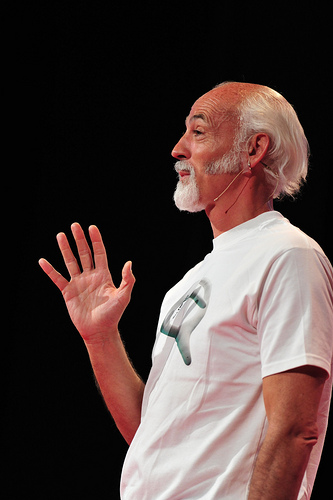
Running notes from TEDGlobal 2009, Session 9.
As a young boy, Lovegrove says, he lived near a cliff shore, where the outgoing tide would reveal fossils that had washed against it. Since that age, he was driven by speculation, by thinking, and the deep inspiration of the forms of nature. Although we call him an industrial designer, his current job, he says, isn’t making things, but “walking, thinking, dreaming.”
Lovegrove unveils his new project, Lovegrove Genesis, which imagines combining ancient biological designs with the modern production of objects. He imagines a spherical “membrane” out of which might be born any form we want to create.
He presents a slide filled with images of ancient biological forms such as diatoms, intermixed with contemporary designs such as a briefcase or a table. By conceptually combining different forms along this grid using what he calls “neural paths,” he finds new types of products that he might be able to generate. For example, a designed object might, over its lifetime (or span of ownership) change its own properties the way a living creature would.
Lovegrove seeks to create a “textural beauty” to his objects, the same kind of beauty natural objects have. There is no “unused side” to any of his designs — you can’t look at the bottom of one of his tables, for example, and find it unvarnished. He shows a video of “single-surface deformation,” which shows how a simple, flat form can evolve to fold and contort into three dimensions to suit a particular need — such as a table. Lovegrove uses computer models to test various designs.
Lovegrove shows the world’s lightest suitcase. Last year, 3.2 billion seats were sold on aircraft, and so lightness of luggage is a very important factor. The suitcase has no lining, but was created as a single mold by a large Japanese company that, he found later, took interest in his project because they were interested in learning new molding techniques.
A humorous moment: “If you keep a straight face, you can get exactly what you want in Japan.” When he designed JAL, he proposed putting a bonsai tree on every seat. Instead of saying no, the firms there did two months of serious research and concluded that they “could not keep bonsai trees alive in a cabin environment.”
Lovegrove points out: “Our ancestors made everything.” They had to make tools and objects that were light enough that they could carry them around everywhere with them. “Lightness is a human objective.”
50% of Lovegrove’s studio’s time is spent on pure research on projects that attempt to achieve these human objectives.
Photo: Ross Lovegrove at TEDGlobal 2009, Session 9: “Revealing energy,” July 23, 2009, in Oxford, UK. Credit: TED / James Duncan Davidson
Comments (1)